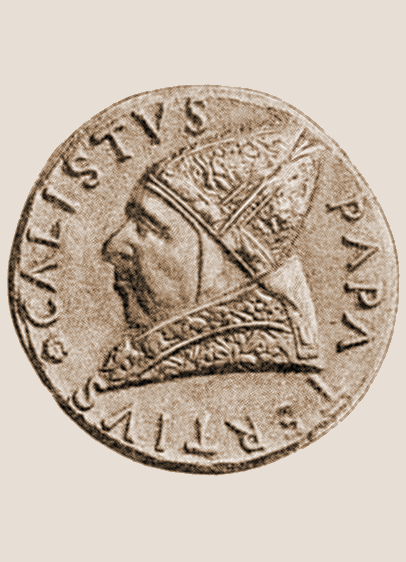Callistus III
April 8, 1455 - August 6, 1458
BACKGROUND
Family and Birthplace
Pope Callistus III (1378-1458) was born in Játiva, a town near the city of Valencia in Aragon, a kingdom in northeastern Spain.
The pope's given name was Alonso de Borja (Alfonso Borgia in Italian). The name was probably derived from the Spanish town of Borja in Aragon.
Education
Callistus studied canon law in Lérida and was a successful lawyer when he was made a cardinal in 1444.
Nepotism and Favoring Spaniards
As pope, Callistus was flagrant in the favoritism he showed to relatives and fellow Spaniards, which aroused much resentment from Italian churchmen. His appointment of family members to civil and clerical posts established the Borgia family in Italy. Callistus' nephew Rodrigo, whom he made a cardinal in 1456, later became Pope Alexander VI. Rodrigo, too, was notorious for enriching Spaniards and relatives, and the legendary intrigues of his son and daughter, Cesare Borgia and Lucretia Borgia, became the subjects of literature and drama.
POLITICAL ACTIVITY
Attempts to Raise a Crusade
Pope Callistus was especially concerned with recapturing Constantinople, which had been conquered by the Turks in 1453. His insistence strained his relations with France and Spain. To finance his efforts, Callistus raised taxes, sold Church valuables like gold and silver objects, and ceased most of the restoration projects around the city of Rome. His military efforts amounted to little more than the use of a large naval force to take back several small islands in the Aegean that used to be controlled by Christians.
Official Acts
Although his pontificate was short, Callistus performed several notable official acts.
●Declared Joan of Arc innocent. Callistus re-opened the case against Joan of Arc, who had been burned at the stake in Rouen in 1431, and in 1456, he declared her innocent.
●Instituted Feast of the Transfiguration. Callistus declared that the Feast of the Transfiguration be universally observed in order to commemorate the first victory by Christian forces against the Ottoman Turks, which was fought by the Hungarians and took place outside Belgrade.
CULTURAL INTERESTS AND PATRONAGE
Collected Manuscripts
Callistus was interested in manuscripts and commissioned the first catalog to be made of the Latin works in the Vatican collection.
Patronage of the Arts
Callistus' priority was foreign policy, and he commissioned no great works of art or architecture and dropped many of the projects begun by his predecessor, Nicholas V.
♦Restoration of Historic Churches. Callistus continued to fund the restoration of the most important of Rome's Early Christian churches.
♦Commissioned plans for new ceiling of Santa Maria Maggiore, Rome. A new coffered ceiling for Santa Maria Maggiore was planned but not carried out until the papacy of Pope Alexander VI, Callistus' nephew.




 Add Placemark
Add Placemark Go Back
Go Back 




